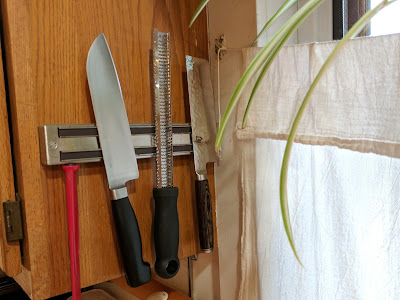The very first tool you need for your knives is a sharpening steel. Despite the name, this item does not sharpen knives. This tool will help to hone the blade as it bends from use. The edge is still there, but hidden by a slight roll that will happen as you use the blade against the surface of the cutting board. A few passes over the steel will make it as good as new in between getting it sharpened properly.
 |
| Sharpening Steel |
A sharpening steel does not have to break the bank, and it doesn't have to be the same brand as the knives you use it with, but do get a good quality one.
Most cooks will likely say that the most important knife to get would be a Chef's style knife. |
| Chef's Knife |
Chef's knives come in several different lengths. You want to use the type you are comfortable with. The shape of the blade helps particularly with having to chop or mince finely, and the width makes a good surface for squishing garlic cloves to remove the skins. More on that when we get to the actual prepping of foods. Of all the knives you want to hold in your hands before purchasing, this is the one and the one you will use the most, especially when just starting out with a good knife set.
 |
| Paring Knife |
Honestly, if the only thing you plan to do is peel vegetables, a good vegetable peeler would suffice. If you want to do fine cuts or peel items with a heavy skin, you will want a good paring knife that fits well in your hand. I use it all the time, but I do understand the concept of not being able to afford everything at once. This one can wait, but I would still pick it up as soon as you can manage. Victoronix has some well rated, inexpensive ones that are (as previously mentioned) well rated with Cook's Illustrated. From the reviews, their paring knife is quite light weight, but is sturdy enough to last a long time.
 |
| Bread Knife |
This knife is not a "necessity" exactly. The reason I consider it indispensable is because the serrated edge is perfect for getting those super thin slices of tomato or homemade sandwich bread. Never use a sharpening steel on a bread knife or any serrated or scalloped edged knife. I hope that the video below will assist with a visual of how to use the steel.
Even when you hone the blade regularly it will eventually get dull and form small nicks in the edge that will need sharpening. I never do this myself. I simply do not feel confident in the craft, so I bring them to a professional who has never failed me. I have a grand total of 7 knifes and it costs under 30.00, though the bread knife needs to be done in a special way that could cost significantly more. Fortunately, the bread knife very rarely needs sharpening.
A final word on caring for your knives: store them properly. Do NOT throw them in a drawer, as you will risk cutting yourself and dulling your knives prematurely. Also, never ever put them in the dishwasher. Just don't do it. Besides the jostling dulling the blade, the detergents used in dishwashers is pretty harsh and will leave your blade pitted over time. I use a dish brush to wash my knives. It has a long handle which keeps my fingers away from the blade while handling a knife that is slippery from soap and water.
Here are some photos of where I keep my knives at the ready:
 |
| Knife Block in "down" position |
 |
| Knife Block in "up" position |
 |
And this is where I keep the knives that don't fit in my block, a magnetic knife strip which is also handy for storing other things like my rasp and lid wand.
|

No comments:
Post a Comment